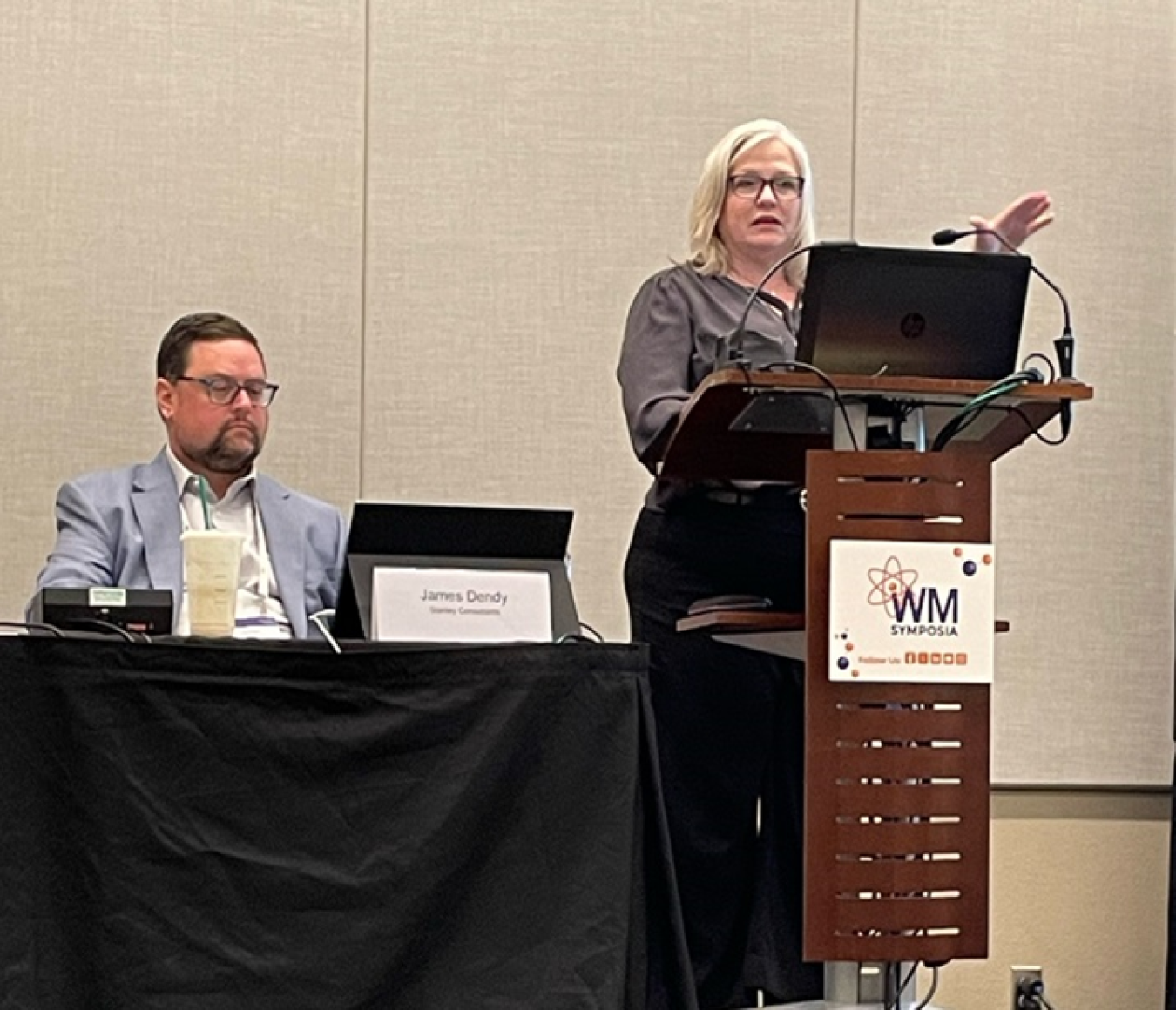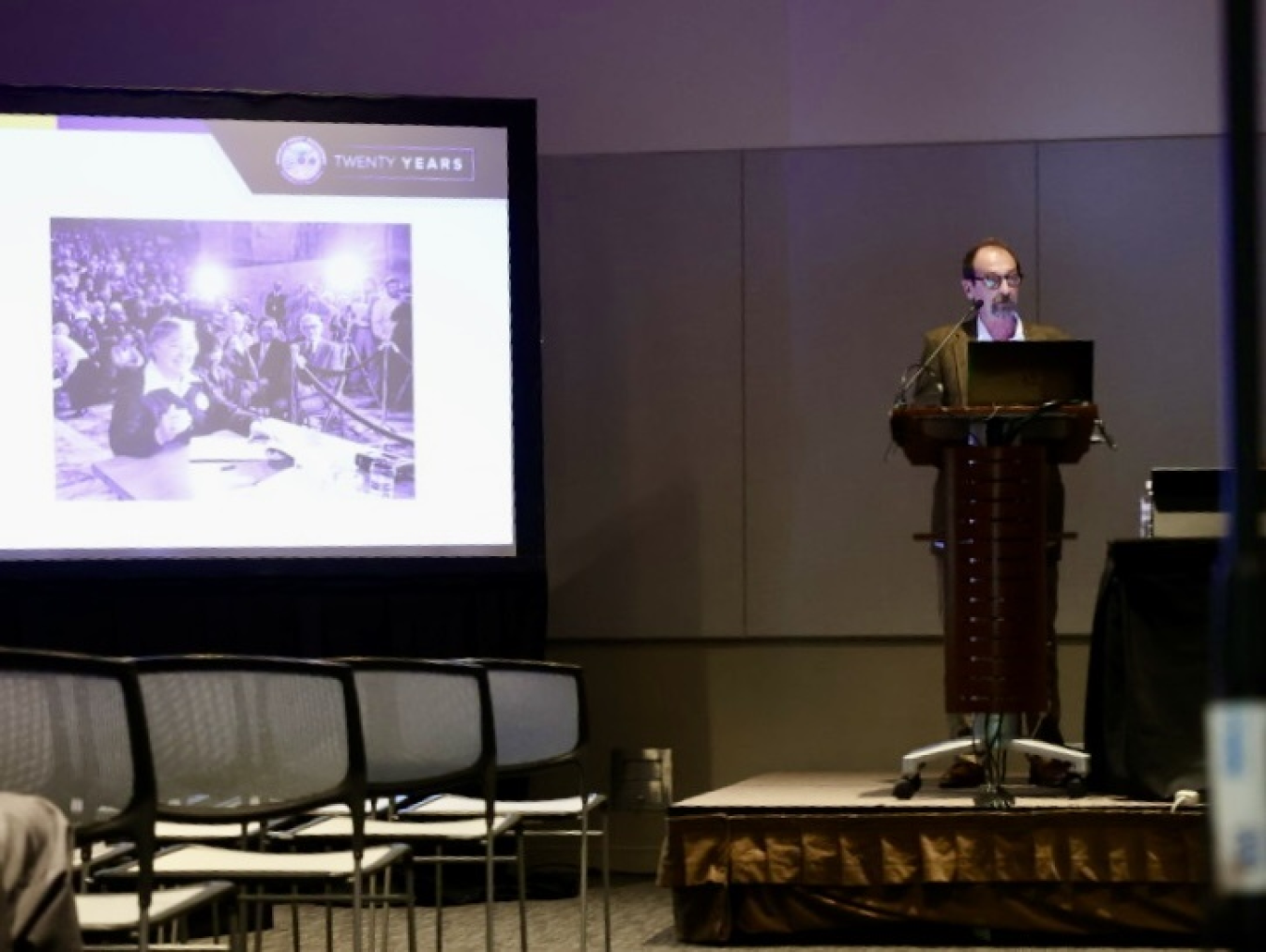Paper presentations included topics related to data governance, FUSRAP
March 14, 2024
LM IT Specialist Annette Moore speaks at a presentation Tuesday titled “Ensuring DOE LM Mission Success Through Governance of Environmental and Geospatial Data” at the Waste Management Symposia in Phoenix.
LM IT Specialist Annette Moore spoke during a presentation Tuesday titled “Ensuring DOE LM Mission Success Through Governance of Environmental and Geospatial Data” at the Waste Management Symposia in Phoenix.
Moore and LM’s Environmental and Geospatial Data Management (EGDM) team are improving their methods of collecting data in the field. Her presentation focused on governance of data sets to improve visibility, accessibility, integration capability, and data reliability for end users. The governance program emphasizes the recognition of data as an asset to help the EGDM team effectively assess change over time.
“Good data governance doesn’t just happen, it has to be built,” Moore said. “Business requirements drive the need for data, and preservation of that data is integral to LM’s long-term stewardship mission. Nothing we do is immediate,” she said. “It’s for the long haul.”
LM has begun to develop and employ formal data governance for environmental and geospatial data. Governance activities include process metrics to ensure that data assets are visible, accessible, understandable, linked (interoperable), trusted (accurate, complete, and current), and secure. The governance model is based on the data management body of knowledge data life cycle, and has been modified for the LM mission, history, and desired workflows.
“Getting to the point of releasing data governance has required a lot of effort as well as buy-in from key stakeholders and senior managers,” Moore said. “Discussion centered on the data model, the process to get to its deployment, and early lessons learned.”
According to Moore, when there isn’t an authoritative source, this is what happens to data: You get it into a place you think is an authoritative source, a couple people export it, they play with it on their laptops, they share it out from their laptops, somebody else makes edits, somebody else makes other edits, and before you know it, you don’t know what the real data is anymore.
LM’s plan to centralize, standardize, and control data as an asset starts with the environmental and geospatial data plan, Moore said.
“The first part of getting healthy is measuring where you’re at,” she said.
An audience member asked Moore if LM was planning to collaborate with other program offices within the U.S. Department of Energy (DOE). The Office of Environmental Management (EM), for example, has data that LM will need once sites transfer from EM to LM for long-term stewardship.
“There’s a couple of opportunities for collaboration. There’s a long-term stewardship networking — which is EM, the National Nuclear Security Administration, and LM — that meets frequently. It is an opportunity to build out some of those standards,” she said.

LM Support Partner Carl Young speaks during a presentation Tuesday celebrating the 50-year anniversary of the Formerly Utilized Sites Remedial Action Program.
Moore said DOE’s chief data officer has begun promoting a data strategy that will give all DOE offices a mechanism to align to the same standards across the entire department.
“It’s definitely where we need to be going,” she said.
FUSRAP at 50
A series of presentations on Tuesday celebrated the 50-year anniversary of the Formerly Utilized Sites Remedial Action Program (FUSRAP) and included a paper completed by LM Site Manager Darina Castillo, LM Program Analyst Padraic Benson, and LM Support Partner Carl Young.
Young outlined the key milestones of FUSRAP, which began in 1974 after the U.S. government strengthened cleanup requirements. The program was established to identify, investigate, and clean up or control sites that were contaminated above guidelines.
Young indicated that nearly 1,000 sites associated with U.S. weapons development and nuclear research have been reviewed and 34 cleanups have been completed. Today, FUSRAP has 21 actives sites being remediated by the U.S. Army Corps of Engineers (USACE), which coordinates with LM for long-term stewardship and beneficial reuse opportunities.
Young also addressed the Middlesex South Site in New Jersey, which was recognized by the U.S. Environmental Protection Agency in 2023 with a National Federal Facility Excellence in Site Reuse Award. The site, also known as the Middlesex Sampling Plant, won the award in the National Priorities List category. The award recognizes the accomplishments of federal agencies, states, tribes, local partners, and developers that restore and reuse contaminated land at federal facilities.
“The FUSRAP program continues to mature,” Castillo said. “The session today highlights the dedicated work of contractors, regulators, and federal teams who are dedicated to innovative remediation and long-term stewardship strategies for these sites.”
USACE has completed remedial investigations, and cleanups are targeted for completion by 2040. LM is using web-based tools to manage sites and share information. For more information, check out LM’s FUSRAP Fact Sheet.
Other session topics in the series included:
- Update of the Radiological Aerial and Ground Survey at the Middlesex Sampling Plant (FUSRAP Site).
- Challenges for Design and Implementation of a Pilot Study in Fractured Bedrock at a FUSRAP Site.
- Implementation of a FUSRAP Environmental Data Management System (FEDMS) for the Storage and Management of Environmental Data.

